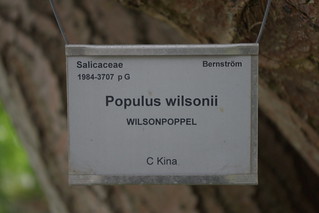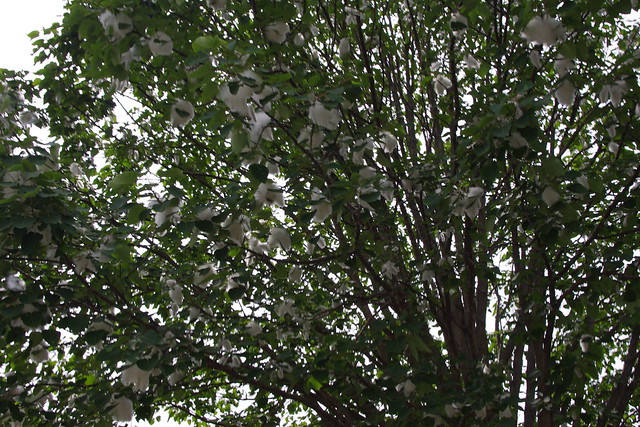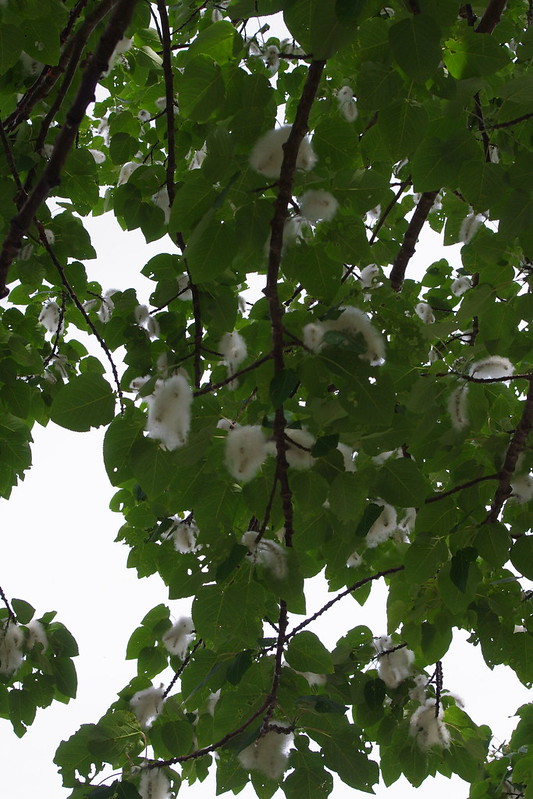“We have a weed here or there,” he said unapologetically.
 |
| Image from Vineyard Golf Club |
 |
| Vineyard Golf Course's Club House |
"Today the Vineyard Golf Club stands as a tribute to what can be accomplished through persistence, collaboration and creativity. Working hand in hand with the local regulatory agencies, naturalists and organic experts from around the world, Carlson and the Grounds Team have established, and continue to maintain, what is reputed to be the most environmentally-sensitive golf course in the world."
(Source)But I loved the actual account as related in the New York Times and I'll repost it here because I find that the Adverstisements and other online junk their pages are rather annoying and who knows how long it will be available to the general public who may not have a subscription to the journal. This seems to be the trend with most former conventional newspapers which are online these days:
EDGARTOWN, Mass. — Standing alongside the 13th green at the Vineyard Golf Club on Martha’s Vineyard, Jeff Carlson spotted a small broadleaf weed between his feet. As the superintendent charged with maintaining the club grounds, he instinctively bent to pluck it, then stopped.
“We have a weed here or there,” he said unapologetically.
It was the rarest acknowledgment in American golf course landscaping — the Vineyard Golf Club is not meant to be as unnaturally perfect as many of the country’s best-known courses.
Opened eight years ago, the club is thought to be the only completely organic golf course in the United States, its 18 holes groomed without the use of a single synthetic pesticide, fertilizer, herbicide or other artificial chemical treatment.
“When we started here, some of my peers thought this golf course would be a dust bowl,” Carlson said, walking across a lush, smooth green toward a rolling, verdant fairway. “I admit I wasn’t so sure it could be done myself. People said we were crazy.”
The club has a more prominent endorsement now. The nation’s first golfer, President Obama, is expected to play here while vacationing this month, after playing the course twice last year.
 |
| Image From Vineyard Golf Club Not exactly what most Agro-Chemical critics would admit when it comes to organically maintained landscaping |
With golf courses increasingly being criticized for environmentally unfriendly practices, the Vineyard Golf Club has become a petri dish for alternative maintenance techniques. Carlson has learned to kill weeds with boiling water and a natural foam cocktail and to remove moss with kitchen dish detergent, and he has transported microscopic worms from Iowa to attack turf-ruining grubs. He has disrupted the mating cycle of damaging oriental beetles with a strategically placed scent and has grown grass that he believes is more resistant to disease because it developed without chemicals.
The staff at the Vineyard Golf Club are now seen as environmental pioneers, with many in the golf industry examining their methods. The club’s organic model could become the successful experiment that helps push thousands of courses toward using fewer pesticides, less water and more natural grass-growing procedures.
“Everyone won’t be able to go fully organic, but we’re proving you can severely cut back on synthetic chemicals,” Carlson said.
When the Vineyard Golf Club opened, it was the first club in 30 years built on Martha’s Vineyard, where the wealthy, many of them environmentally conscious but also accustomed to playing on chemically enhanced private courses, have long kept summer homes.
Opposition to the project on this liberal-leaning island was fierce. It helped the project that the land was also zoned for a 148-lot subdivision. The Martha’s Vineyard Commission eventually allowed the course to be built with conditions prohibiting the use of any product whose active ingredient was synthetically produced.
Bill Wilcox, a water resource planner for the commission, called the club a good neighbor and said he knew of no major complaints against it.
Although the club is private, with 288 proprietary members — the initiation fee is $350,000 with annual dues of $12,000 — the deal with the commission includes a condition that 125 island residents be accepted as members with no initiation fee and annual dues of $725.
Carlson, 61, had experience building a golf course with conservationists watching, having worked with the noted architect Michael Hurdzan during the 1990s in the creation of the Widow’s Walk Golf Course in Scituate, Mass. That course is known as America’s first environmental demonstration course, although it was maintained with some synthetic materials.
“Nobody had tried what we were trying,” Carlson said.
Cruising the Martha’s Vineyard club on a golf cart last week, Carlson recalled one of his earliest jobs in the business, in which he mixed mercury-based fungicides by hand, occasionally near the on-course house where he lived with his wife, Kathy.
 |
| Image from Vineyard Golf Club |
“Kathy has beautiful, thick red hair, and it started to fall out,” he said. “She went to the doctor, who did some tests and was told she had heavy-metal poisoning. Obviously, I stopped using that stuff. All these years later, it has been kind of satisfying to be trying something so very different.”
In the golf community, there is no clear definition of what constitutes an organic course. A 79-page report prepared by a consortium of golf and environmental experts proposed definitions earlier this year but did not settle the issue. The report listed about two dozen courses that call themselves organic, but noted that most used some synthetic chemical pesticide, fertilizer or wetting agent.
“The Vineyard Golf Club has gone further than anyone organically, especially for that level of golf course and considering what they’ve achieved over the years,” said Paul Parker, the chief author of the report. When Vineyard Golf Club opened in 2002, Carlson was in hand-to-hand combat with fungal diseases, insects, grubs and the skunks, crows and raccoons that tore up the turf to get to the grubs. There was also the matter of teaching the membership that nothing in the rules of golf mandated that the game always be played on green grass.
“We had to promote the notion of playability rather than visual perfection,” Carlson said. Still, the grubs were particularly vexing. A synthetic insecticide application would have made things easy. But Carlson discovered a specific kind of beneficial nematode, a roundworm that would attack the grubs from within the soil. It occasionally meant flying in the nematodes from Iowa packed in dry ice.
When it came to the skunks, crows and raccoons, the club went old school. It turned to a retired local fisherman — whom some have compared to Carl Spackler, the character played by Bill Murray in the golf movie “Caddyshack” — who was known on the island for his ability to trap and remove those creatures.
Nothing at the Vineyard Golf Club, now in its ninth season, is left to chance. To prevent fungal disease, crews go out daily at dawn using a long, whip-like device that whisks condensation off the grass throughout the course’s 69 acres. And visitors have their shoes cleaned before they play to keep contrary grass seeds or diseases from infiltrating the fairways and greens.I've split this paragraph into two parts here above and below, because I'd like to interject my own personal thoughts on what was stated here. I love the fact that they have a large crew here for the hands on maintenance. Clearly it's a lot of work, but enjoyable work just the same. With the 10s of 1000s of dollars not spent on synthetic fertilizers, herbicides, fungicides, insecticdes and water savings as a result of having extremely thirsty plants because of the over fertility caused by synthetics, they can now hire and pay for more employees. More jobs and safer environment for the whole community.
The club’s maintenance labor budget is higher than those of most clubs its size, but Carlson said his net costs were the same “because of the money we save on traditional pesticides, which are very expensive.”
The Vineyard Golf Club greens are devoid of weeds or major blemishes, and they roll true and consistent. The fairways have patches of crabgrass and clover that are barely noticeable. What is most obvious in a walk of the holes is a striking and scenic layout pocked with deep, distinctive sod-faced bunkers designed by the British architects Donald Steel and Tom Mackenzie.
“Yes, it is not perfect out there, but even if your ball comes to rest next to a shaved-down broadleaf weed, it’s not going to affect your shot,” said Gene Mulak, the club’s golf pro.
Private golf course members are notoriously hard on superintendents, but Carlson says those at the Vineyard Golf Club are “real environmental pioneers because they put down the money for this experiment.”
Sally Rorer, a charter member, said members were proud of the club’s organic approach.
“It makes it easier to put a sandwich down on the ground between shots, too,” she said.
What practices and techniques might be transferable from Martha’s Vineyard, where golf courses are generally open only eight months a year, to other parts of the country is debatable.
“Most golf courses wouldn’t make it with an approach so organic, especially year after year with changeable weather,” said James Snow, the national director of the United States Golf Association’s Green Section. “But over time, we’re going to be using less synthetics, and that’s a good thing.
These days, walking past the occasional weed, Carlson has moved on to other goals.
“We’re trying to be like any other golf course,” he said. “I don’t want people to come here and say, ‘That was a real good golf course for an organic golf course.’
“I hate hearing that.”
(Source - New York Times by Bill Pennington)
~~~~~~~~~~~~~~~~~~~~~~~~~~~~~~~~~
Concluding Comments and ReflectionThe beauty of this organic landscape maintenance example is that it is yet another illustration of how a holistic approach through biomimicry [which is replication of Nature] can be successfully implemented with fantastic results on a large commercial scale. This is something the Agro-Chemical and Biotech Corporate business interests say cannot be done with any real serious commercial venture without their help, be it Farming, Urban Landscaping, etc. Here are a couple more examples of big commercial operations [one Farm & one University Campus] who have successfully done what the Vineyard Golf Club has done and the Agro-Chemical industry is livid. Why ??? Because these operations have completely eliminated all synthetic inputs and rely on beneficial bacteria and mycorrhizal fungi colonizing plant roots which provides enhanced water uptake and both nutritional and immune system needs. Mostly it's a change in practice. The first example are the grounds keepers at Harvard Yard who were severely criticized back in 2009 by the Garden Professors at Washington State University who are often committed to industrial science business interests for no other reasons than the claim of peer-review, scientific consensus and the illusion of a practice of something as science-based. Although to be fair, they do provide some good insight and helpful advise about organic practices, but they are adamantly against compost tea even to the point of putting down some of the efforts of their own fellow colleagues at the Extension Service who actually put on a great well balanced webinar on Compost Tea.
Here is an article I wrote in response to the WSU Professors thrashing they spearheaded against the successful Harvard Yard Groundkeepers and their own eXtension colleagues for providing information through a very informative well done webinar on the use, recipes and research being done on compost teas.
WSU Garden Professors attack Harvard Yard Soil ProjectAnother wonderful example of a commercial venture is a 5,400+ acre farming operation outside of Bismark North Dakota by farmer Gabe Brown who has stopped using synthetic inputs and having fantastic results and like Harvard Yard and Vineyard Golf Club is saving 10s of 1000s of dollars in the process. He manages his land by nurturing the soils mycorrhizal fungi and beneficial bacteria by keeping his fields continually covered with a 20+ biodiverse mix of perennials in pasture [because mycorrhizal fungi needs a continual host], grazing cattle and planting crops all on the same land with a no-till process which leaves the ground micro-organism infrastructure intact instead of killing them with conventional tilling and synthetic chemical inputs. You can watch this video which features Gabe Brown and his Keys To Building a Healthy Soil, filmed on Nov. 18th 2014 at the Idaho Center for Sustainable Agriculture's annual symposium.
Some of the more interesting photos on their website's gallery were these two photos of the sand traps surrounded by what appears to be the low growing native vegetation of their region. This made me think of ways and examples the west coast golf courses could also use many specimens of coastal sage scrub and some high desert plants in the same ways. There was one paragraph which seemed to sum up what other varied geograpphically located golf courses could do to incorporate many of Vineyatd's ideas, but also specifically tailor them to their own region. This is important not only from a maintenance perspective, but also a localized ecological one which enhances the natural ecological habitats within any given locality. Here are those pics below.
 |
| Image from Vineyard Golf Club |
 |
| Image from Vineyard Golf Club |
I love those pics. For me they are illustrative of the mountain high terrain in eastern San Diego County in California where such application could be implemented at another golf resort called Warner Spring Ranch Resort . For that matter all of the other golf courses of Southern California, including those of the deserts southwest could follow this example since an organic approach which utilizes and encourages micro-organisms allow less water to be used, something that is a rare and expensive commodity out there. And this is irrelevant whether the water comes from an effluent gray water source. Take a look at some example photos below of the Warner Ranch Resort golf course.
 |
| Image from Warner Spring Ranch Resort |
 |
| Image from Warner Springs Ranch Resort |
 |
| Image from Warner Springs Ranch Resort |
Successful organic landscape examples on a commercial scale are desperately needed in a world where the prevailing Scientific Orthodoxy insists we need the Biotechs & Agro-Chemical comapnies if the world is going to survive. And they have the world's power and wealth to back up their claims. Truth be said, it is these very same companies from their earliest origins at the beginning o the 20th Century who have literally dismantled and reverse engineered the Earth by means of abuse and misuse of Science. Clearly, their are other scientific studies and ecologically minded organizations which time and again have proven the industrial science business model to be dead wrong. But one of the greatest allies the Industrial Science world has on it's side when t comes to propaganda storytelling is the global Media. Recently there was an article explaining why and how this major gray area journalism culture operates. The article's title is, "Is Most Science News Bull****?"
http://primemind.com/articles/is-most-science-news-bull****?
"If we want to live our lives based on evidence (and who doesn’t?), it makes intuitive sense to live according to what we read in the science section of the newspaper. First things first, don’t do that. Newspapers are actually one of the worst places to get information about scientific matters. Now this isn’t some kind of revelation. Anyone with a good understanding of science knows this is as clear as night and day."Unfortunately the media is where most average people get their science education and understanding. Today's modern society living in a further and further dismantled world where life seems to have less and less purpose are for the most part apathetic. Like the old time religion of the past, most people are lazy and allow the prevailing ruling Scientific Orthodoxy to do their scientific study, research and thinking for them. That article further explained why journalists are not more honest and thorough in producing a well balanced and well thought out educational reads.
"This is because a well-considered and balanced article is not only time consuming and challenging to write, but ultimately sells less copies, brings in less traffic, and consequently less advertising dollars than shock-horror headlines. All journalists who want to tell substantive, well-researched stories face this problem."Humans under the failed leadership of political, Commercial & Religious elements have gradually dismantled this planet's life sustaining natural systems which has been accelerated since World War I thanks to the misuse and abuses of science. Quite literally our Earth (Home) has been trashed and abused for it's natural resources to such a degree that many parts are becoming unlivable. Hence the migration of people to the prosperous industrial countries. And yet very few are taking not. This question begs, Why is the average human content with living in a home in an ever growing homeless world ?
~~~~~~~~~~~~~~~~~~~~~~~~~~~~~~
Some Interesting References
New York Times: Exclusive Golf Course Is Organic, So Weeds Get In
New York Times: The Grass Is Greener at Harvard
Brown's Ranch: Regenerating Landscaoes for a Sustainable Future
https://www.warnerspringsranchresort.com/championship-golf.html
Reclaimed Water: Municipal Projects, CalTrans Landscaping & Pompous Grass Resorts
In Pursuit of the Perfect Lawn (& Why I've always hated Lawns as a Landscaper)
Native Plants, Micro-Organisms & Habitat Building Resources for creating commercial Ecological Habitats through Biomimicry
California Chaparral Institute
Las Pilitas Native California Plants Nursery
Tree of Life Native Plants Nursery
Mycorrhizal Applications Inc
Lebanon Turf & Biologicals
http://www.valentbiosciences.com
Some Great News in the Biological Controls Research & Development Department
The article in Entomology Today dealt with grub issues in the lawns that the Vinetard Groundskeepers had to deal with. Here is the latest from the online journal Entomology Today on potential biological controls:
Journal of Integrated Pest Management (JIPM) Article on Masked Chafer Grubs in Turfgrass Explains Management Techniques


































